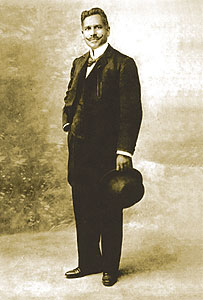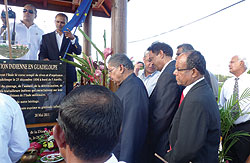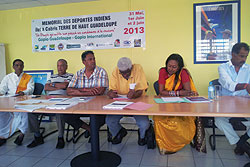Five hundred and twenty years ago, Guadeloupe, the volcanic French West Indian island in the Lesser Antilles between Antigua and Dominica, became part of modern history. Under a monetary arrangement with Spain’s King Ferdinand and his wife Queen Isabella on receiving royalty on riches discovered, the Genoa-born explorer Christopher Columbus was settling new lands in the West Indies. In 1493, while seeking fresh water on his second trip to the Caribbean, Columbus became the first European to land in Guadeloupe. With Columbus’ visit, the history of the island was forever changed. Spanish conquest of this present island was followed by British and French rule.
Today Guadeloupe is an overseas department of France, administered by a prefecture. There are about 55,000 people of Indian origin in Guadeloupe’s total population of just over 4,05,000. The Indian origin people are French citizens, descendants of indentured workers (barring a handful of modern day immigrants who arrived for business). All of them have a deep sense of longing and wish to connect with India. They have not forgotten the land of their ancestors.
ARCHIVE PICTURES

Guadeloupe -
Family of Indians working in the Cane Sugar

Guadeloupe - In Malabars and pangol
|

Guadeloupe - An Indians immigrants family

Henri Sidambarom
|
Life for their forbears when they started arriving in the island in 1854 wasn’t quite easy. The sailing period from the shores of Pondicherry and Calcutta was far too long, usually three months. The Indians were not used to prolonged exposure to the rough seas, and many suffered from sea sickness and other diseases on board. The numbers who actually disembarked in the West Indies inevitably dropped from the numbers who embarked on board. Between 1854 and 1883, out of the 42,873 Indians who sailed from India to Guadeloupe, only 39,800 disembarked alive. Some also arrived from places like Trinidad and Tobago (then part of the British West Indies) under hastily prepared informal business agreements between British agents and French plantation owners in Guadeloupe. The bulk (about 70 per cent) emigrated from the south of India via the port of Pondicherry. The rest came from the eastern region, including the French outpost at the time—Chandernagore. Right up front on arrival they were to be greeted by tough taskmasters and hostile conditions, not the best of starts to their new life. The dreamy world they had envisioned wasn’t quite so. Says Michel Narayninsamy, president of GOPIO Guadeloupe and descendant of indentured workers, “we have survived against all odds. Our forebears found it extremely tough to carry out hard physical labor. We were cut off from India. Today, both India and the Indian diaspora ought to know a bit of that past, that history that has shaped our destiny in this remote island.”
LOW REPATRIATION
Dr Christian Schnakenbourg, Professor Emeritus at the University of Provence, France, has researched the patterns of Indian emigration to Guadeloupe between 1848 and 1923. Here are some highlights of his research:
- Many died in Guadeloupe because of the harsh conditions of work and the savage nature of some of the plantation owners. The registers in the commune of Moule, for instance, show that 34 per cent of the Indians died within the first three years of their arrival at the commune, while 45 per cent died within five years. This is mortality of the highest order, almost close to wiping out an ethnic group. At the peak of emigration between 1855 and 1885, the mortality rate was 61.4 for every 1,000 persons that arrived in Guadeloupe from India. In comparison, it was 28.7 for every 1,000 for the Creole (mixed) population with majority African ancestry. The high mortality figures for Indians are matched only by those nations that have gone to war or have been affected by natural disasters on a large scale. While modern day wars and natural disasters last for limited periods, the figure (61.4) for the Indians is averaged over as long as 30 years.
- The plantation owners tried all means to keep Indians for lengthier periods of time. Figures at Moule once again indicate that even though the indentured workers had a contract for five years (60 months), they usually worked 78 months (6 years and 6 months) before any talk of repatriation could even begin. And all this while Indians were desperate to return, and were counting their days in Guadeloupe. Even after the contract was over, they were put under enormous physical and psychological torture and forced to carry on. The justice system was non-existent, and the Indians had no one to turn to for relief. A British official, Major Cummins who visited Guadeloupe reported that the Indians were retained “until they were of no use”. Such was their condition.
- Convoys for repatriation were deliberately delayed. When budgetary provisions were made, the expenses of the convoys were not considered priority. In fact, such budgetary provisions were usually cut back without any reasons. The Indians were entitled to free return passage on completion of their indentured period. They were somehow tortured or lured to continue with their hard labour in Guadeloupe so that the economic gains of the empire from the sugar plantations could continue.
- Between 1861 and 1906, 28 convoys left Guadeloupe for India with a total of 9,700 Indians. Of these, one, Uncle Felix, returned to Guadeloupe from the mid seas. Repatriation picked speed after 1882 following enormous pressure from the British who found French practices of the time quite unfit for humans. Eight convoys with 5,252 aboard left Guadeloupe in the 9-year-period between 1882 and 1891 alone to speed the returns. But it was too little too late.
- Overall figures suggest that of the 42,873 Indians who arrived in Guadeloupe between 1854 and 1889, only 22.6 per cent were repatriated. If repatriation is taken into account of only the parents and children born in the island during the period of indentureship to such repatriated parents is excluded, the figure drops to 20 per cent.
- In comparison, the repatriation percentage from Martinique stood at 46.8 per cent, and for Suriname, Guyana and Trinidad and Tobago stood at 32.5, 30.1 and 30.6 per cent respectively.
LIFE IN THE PLANTATIONS
Life in the plantations was very hard. The minds of the plantation owners were still set in the slavery period. Even though slavery itself had been abolished by France on April 27, 1848 by law, the plantation owners wanted to exploit the Indian workers ruthlessly, even savagely. Indians who wanted to return home after the completion of the indenture period of five years were often not allowed to do so. Unscrupulously, the plantation and estate owners would flaunt contract documents before the Indians who could hardly read or write a word of French. They were told that holidays would not count, so they had to work more in order to serve out the indenture. The servitude of the Indians was thus extended by months and years. Most of those who arrived were to also lose their emigration documents over time. The record rooms would mysteriously catch fire, and the documents would be forever lost. This ensured that future generations would find it almost impossible to track down their ancestral roots in India.
Indians in Guadeloupe say that when the children of the first batch of indentured labour started to grow up, some of the parents became reluctant to leave the island as much time had passed since their journey from their ancestral villages. Resettling back in India with the children who were now forced to speak French could be an arduous task. Discouraged from returning to India, many of the indentured workers continued to labour hard, hoping that the future would turn out to be better. Their ties with India were permanently cut. The blood, sweat and copious amounts of tears that they shed at the sugarcane plantations wasn’t wasted as far as the colonial power and plantocrats were concerned—they helped swell the coffers and treasuries of France. Even as the sugar economy in the island boomed, the physical and financial condition of the Indian indentured workers remained far from healthy. For a considerably long period, they even remained citizens of nowhere with neither Indian passports nor French ones.

Mr Michel Narayninsamy
|

In 2011, Minister for Overseas Indian Affairs, Mr Vayalar Ravi visited Guadeloupe and inaugurated a memorial dedicated to the Indian diaspora that had settled in this island, starting 1854
|
|
|

Mr Michel Rogers
|

A press conference for the international media was held in Guadeloupe by GOPIO International. Seen from left are Pandit Rajendra Shastri, Mr Kumar Moorjani, local businessman settled in the French West Indies since 1980, Mr Michel Narayninsamy, president of GOPIO Guadeloupe, Mr Michel Rogers, historian, researcher and genealogist, Ms Francine Petapermal, historian and researcher, Mr Jean-Marie Gobardhan, businessman and GOPIO member
|
MISLED
Some of the Indians who were recruited in the India for work in Guadeloupe were lured by stories of how they’d find gold when they reached their destination. The stories were, of course, baseless, but played on the minds of the underprivileged classes. After undertaking perilous voyages across the Indian and Atlantic oceans, the Indians discovered that they’d been tricked by the recruiting agents. There was no gold. Instead, they were asked to cut down sugarcane from dawn to dusk, and until they would fall from fatigue. Outraged at the lies of the recruiters, some of the Indians would want to return home. A few that had the courage would try and rebel, but the whips of the plantation owners and the sight of the guns of the French police were usually enough to silence them.
But not everyone could be silenced by the whips or the sight of the guns. At the Ilet A Cabrits (see cover picture, and separate story) lies a secret that has been unraveled only in 2012. Thirty four Indian men and one woman that rebelled and wished dearly to return home were forcibly sent to a prison in this isolated island. This information was dug out from the archives by Michel Rogers, 75, a research, historian and genealogist. The 34 men and single woman were chained inside small cells and guarded day and night. There was no way to escape, because after the prison lay the waters and the sharks. It does appear that in order to teach them a lesson, all 35 were left to die. They could not have died if normal prison rules were followed, and they were fed regularly. This story of imperial high-handedness and scant respect for the life of a human being remained a secret until in 2012 records were dug up from the archives.
150th ANNIVERSARY OF HENRI SIDAMBAROM
The Indian community in Guadeloupe is indebted to the efforts of one of its most loved sons, Henri Moutou Sidambarom. He was born in 1863 at Capesterre-Belle-Eau in the island. He developed political ambitions and defied every possible odd to become a municipal councilor, first at Pointe a Pitre, the capital, and then at Capesterre-Belle-Eau. Later, when he tried to contest as a mayor, the French Government exerted pressure on his party and he was ousted from its ranks on the grounds that he was an Indian and not a French.
Sidambarom’s never-say-die attitude then came to the fore. His endurance was stretched to its limits as he fought bitterly to ensure that Indians who were stateless where given French citizenship. It took him long, but finally in 1923, following a 19-year pursuit and fight, the authorities in France relented and Indians were accepted as French nationals. But for Sidambarom’s tireless leadership against social malpractices, the situation for the stateless Indians could have worsened.
ON THE WAY UP
Coming out of servitude and economic backwardness has taken a long time. But today, Indians are by and large a prosperous community. Their enterprising nature has earned them a reputation of being good businessmen, like elsewhere in the world.
It is on the cultural front, though, that the people of Indian origin want recognition. They know that the PIO card is almost out of reach for them because their emigration documents are no longer available at French archives, having been systematically destroyed. This was done in order to ensure that the Indians could no longer retain their Indian identity or if later generations wished, could no longer return to their native places in the absence of documentation. The emigration documents are a requisite in India for granting PIO cards. But there is hope. Some of their brothers and sisters in Reunion Island, a French overseas department in the Indian Ocean, have received the PIO cards. They could have well have set a precedent for PIO cards to be issued by the Government of India to those in Guadeloupe.
The story of the Indian community in Guadeloupe remains fascinating and moving at the same time.
|